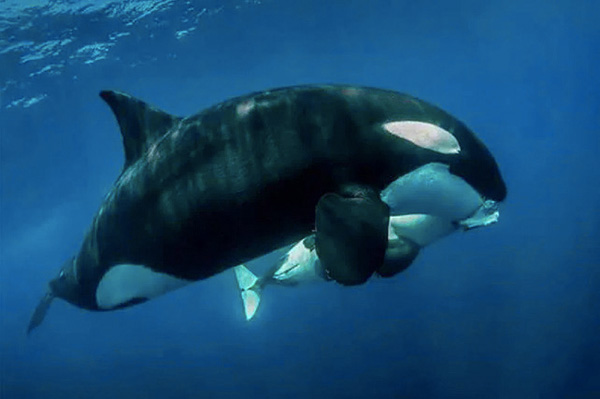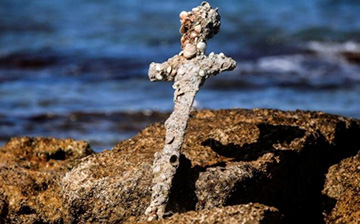Flotsam & JetsamContents of this Issue: Riding Rock Resort, San Salvador, Bahamas Indonesia Begins to Reopen for Diving Trips – Maybe Not! The Pacific Quartet, the Caribbean, and Great Whites The Boy in October Sky Became a Man Who Taught Astronauts to Dive Car Tires Discarded in the Ocean Trap Hermit Crabs Forever U.S. Dive Boat Owner’s Liability Might Increase Dive Travel in the Time of Coronavirus The GoPro Selfie-Stick as Unwanted Shark Bait Anything It Takes to Get My Shot PFO – That Perfectly Formed Hole It’s Not OK to Sell Dive Gear to Libya American Gold Salvors Spared Criminal Action Editorial Office: Ben Davison Publisher and Editor Undercurrent 3020 Bridgeway, Suite 102 Sausalito, CA 94965 from the November, 2021 issue of Undercurrent
Divers Attacked by Birds. Flightless cormorants, unique to the Galapagos Islands, can dive to impressive depths without trouble to catch prey. However, some have recently taken an interest in scuba divers underwater, pecking at them and their equipment. One explanation is that the birds mistake air hoses and other scuba equipment for eels or fish. They don't hurt divers. They just amuse them with the attention they pay. A Tribute to Bruce Bowker. The former owner of Bonaire's Carib Inn, Bruce was awarded a tribute by STINAPA (National Parks Bonaire Foundation), a nongovernmental organization responsible for managing Bonaire's national parks. They renamed a popular dive site "Bruce's Rappel" in his memory and for the work he did to promote conservation and diving tourism (Our publisher, Ben Davison, dived Rappel with Bruce and Captain Don 40 years ago). You can see a video of the tribute here: www.facebook.com/watch/?v=1011650023022834
Nature Red in Tooth and Fin. While orcas are also called killer whales, it's rare to photograph one killing and eating a dolphin. However, that's what Evans Baudin, the owner of Baja Shark Experience in Baja California Sur, achieved. Diving near Los Cabos with his camera, he witnessed an orca pod hunt and devour a bottlenose dolphin. He says, "The dolphin had no way of escape. The hunt lasted about 40 minutes before the group of killer whales could finally capture the dolphin and share it." Mexico News Daily Ten-Year Study Reveals Coral Reefs in Crisis. The Khaled bin Sultan Living Oceans Foundation, a U.S.-based nonprofit environmental organization dedicated to providing science-based solutions to protect and restore ocean health, has run a global reef expedition with its research vessel MY Golden Shadow, traveling extensively to map the coral reefs of the Red Sea, the Atlantic, Pacific, and Indian Oceans. The Global Expedition Final Report has just been published, and, as expected, it's not good news. https://tinyurl.com/ymstdsvc Don't Tell the Tooth Fairy. Familiar to most California divers and a favorite target for spearfishers, the Pacific lingcod ranges from Alaska to Baja California, Mexico. An ill-tempered, omnivorous fish with a mouth like a messy silverware drawer, its 500-plus teeth are arranged haphazardly on two sets of highly mobile jaws. New research, published this month in the scientific journal Proceedings of the Royal Society B, reveals that it loses and replaces an average of 20 teeth every day. Perhaps teeth aren't as irreplaceable or precious as we thought.
Diver Finds 900-Year-Old Sword. An Israeli recreational diver has discovered a sword thought to have belonged to a Crusader knight about 900 years ago. With a three-foot blade encrusted in marine organisms, the sword, in excellent condition, was found on the seabed near Haifa and handed over to the Ministry of Antiquities. The Carmel coast, where the blade was found, has provided shelter for ships during storms throughout centuries of shipping; Roman ships' stoves, lead cooking pots, and Ottoman soldiers' helmets have also been recovered there. BBC |

I want to get all the stories! Tell me how I can become an Undercurrent Online Member and get online access to all the articles of Undercurrent as well as thousands of first hand reports on dive operations world-wide
| Home | Online Members Area | My Account |
Login
|
Join
|
| Travel Index |
Dive Resort & Liveaboard Reviews
|
Featured Reports
|
Recent
Issues
|
Back Issues
|
|
Dive Gear
Index
|
Health/Safety Index
|
Environment & Misc.
Index
|
Seasonal Planner
|
Blogs
|
Free Articles
|
Book Picks
|
News
|
|
Special Offers
|
RSS
|
FAQ
|
About Us
|
Contact Us
|
Links
|
3020 Bridgeway, Ste 102, Sausalito, Ca 94965
All rights reserved.


 Please Don't Feed the Whale Sharks. Oslob, in Cebu province, the Philippines, became a global draw for tourists thanks to the whale sharks that congregate nearby. But human feeding has changed their behavior, encouraging them to spend more time near the surface, resulting in abrasions from boat collisions. But since tourists are practically guaranteed sightings, locals have no intention of abandoning the feeding, despite the growing pressure to stop. It's given the town of Tan-Awan a commercial boom, but the World Wildlife Fund urges tourists to go to see whale sharks at Donsol, where they aren't fed (but then again, they're less likely to see the behemoths). Singapore Today
Please Don't Feed the Whale Sharks. Oslob, in Cebu province, the Philippines, became a global draw for tourists thanks to the whale sharks that congregate nearby. But human feeding has changed their behavior, encouraging them to spend more time near the surface, resulting in abrasions from boat collisions. But since tourists are practically guaranteed sightings, locals have no intention of abandoning the feeding, despite the growing pressure to stop. It's given the town of Tan-Awan a commercial boom, but the World Wildlife Fund urges tourists to go to see whale sharks at Donsol, where they aren't fed (but then again, they're less likely to see the behemoths). Singapore Today